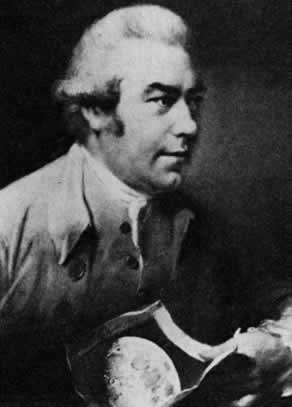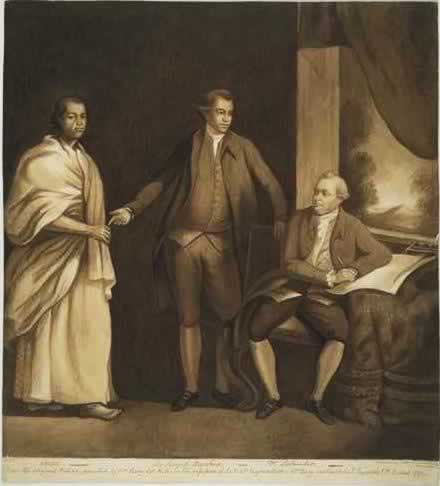Think that you may own a portrait of Sir Joseph Banks? We identify, appraise and issue Certificates of Authenticity (COA) for all portraits of Sir Joseph Banks.

Sir Joseph Banks by Joshua Reynolds 1773
Sir Joseph Banks was an English naturalist, botanist and science patron. He took part in Cook's first great voyage (1768–1771) and around 80 species bear Banks' name. He is credited with the introduction to the West of eucalyptus, acacia, mimosa, and the genus named after him, Banksia.
Banks was born in London to the wealthy William Banks, a prosperous Lincolnshire country squire and member of the House of Commons, and his wife Sarah, daughter of William Bate. Joseph was educated at Harrow School from the age of 9, and at Eton College from 1756; his fellow students included Constantine John Phipps. As a boy, he enjoyed exploring the Lincolnshire countryside and developed a keen interest in nature, history and botany. When Banks was 17 he was inoculated with smallpox, but he became ill and did not return to school. In late 1760 he was enrolled as a gentleman-commoner at Oxford University. At Oxford he matriculated at Christ Church and his studies were largely focussed on natural history rather than the classical curriculum. Determined to receive botanical instruction, he paid Cambridge botanist Israel Lyons to deliver a series of lectures at Oxford in 1764.

Sir Joseph Banks in “The Greening of the Empire” by T.H. Watkins
He left Oxford for Chelsea in December 1763. He continued to attend until 1794, but he left that year without taking a degree. Banks' father died in 1761, and when he turned 21 Banks inherited the impressive estate of Revesby Abbey, Lincolnshire he became the local Squire and Magistrate, sharing his time between Lincolnshire and London. From his mother's home in Chelsea, he kept up his interest in science by attending the Chelsea Physic Garden of the Society of Apothecaries and the British museum, where he met Daniel Solander, and he began to make friends among the scientific men of his day and to correspond with Carolus Linnaeus, whom he came to know through Solander. As Banks' influence increased, he became an advisor to King George III and urged the Monarch to support voyages of discovery to new lands, hoping to indulge his own interest in botany.
In 1766 he was elected to the Royal Society, and in the same year accompanied Phipps to Newfoundland and Labrador with a view of studying their natural history. He established his name by publishing the first Linnean descriptions of the plants and animals of Newfoundland and Labrador.

Sir Joseph Banks by Thomas Phillips, 1808-1809
He was promptly appointed to a joint Royal Navy/Royal Society scientific expedition to the south Pacific Ocean on HM Bark Endeavour, 1768- 1771. This was the first of James Cook's voyages of discovery into that region. This voyage went to Brazil were Banks made the first scientific description of a now common garden plant, bougainvillea (named after Cook's French counterpart, Louis-Antoine de Bougainville) and other parts of South America. It went on to Tahiti (where the transit of Venus was observed, the primary purpose of the mission), New Zealand, and finally to the east coast of Australia where Cook mapped the coastline and made landfall at Botany Bay near present-day Sydney and at Cooktown in Queensland, where they spent almost seven weeks ashore while their ship was repaired after foundering on the Great Barrier Reef. Before he left England, he had become a Freemason and is thus held to be the first Freemason known to have been in New Zealand and Australia. While in Australia, Banks, and the Swedish and Finnish botanists Daniel Solander and Dr. Herman Spöring made the first major collection of Australian flora, describing many species new to science. Almost 800 specimems were illustrated by the artist Sydney Parkinson and appear in Banks' Florilegium, finally published in thirty-five volumes between 1980 and 1990.

Sir Joseph Banks with Omai and Dr. Daniel Solander, 1838, by Theodore von Holst
Joseph Banks arrived back in England on 12 July 1771 and immediately became famous. He intended to go with Cook on his second voyage which began on 13 May 1772, but difficulties arose about the accommodation for Banks and his assistants, and he decided not to go. In July of the same year he visited Iceland with Daniel Solander aboard the Sir Lawrence and returned with many botanical specimens. When he settled in London he began work on the Banks' Florilegium. He kept in touch with most of the scientists of his time, and added a fresh interest when elected to the Dilettante Society in 1774. He was afterwards secretary of this society from 1778 to 1797. On 30 November 1778 he was elected President of the Royal Society, a position he was to hold with great distinction for over 41 years. He married in March 1779, Dorothea. daughter of W. W. Hugesson, and settled in a large house in 32 Soho Square, now occupied by 20th Century Fox, which continued to be his London residence for the remainder of his life. His sister Sarah Sophia Banks lived with Banks and his wife. There he welcomed the scientists, students and authors of his period, and many distinguished foreign visitors. He had as librarian and curator of his collections, Solander, Jonas Dryander, and Robert Brown in succession.

Sir Joseph Banks, lower left in red coat, with fellow explorers and naturalists Dr. Daniel Solander (at left), Dr. John Hawkesworth and Earl Sandwich by Mortimer
He was made a baronet in 1781, three years after being elected president of the Royal Society. The latter position he would hold for a record forty-two years, and from it he could direct the course of British science for the first part of the 19th century. During much of this time, Banks was an informal adviser to King George III on the Royal Botanic Gardens, Kew, a position that was formalized in 1797. Banks dispatched explorers and botanists to many parts of the world; through these efforts Kew Gardens became arguably the pre-eminent botanical gardens in the world, with many species being introduced to Europe through them. He was directly responsible for several famous voyages, including that of George Vancouver to the Pacific Northwest of North America, and William Bligh's voyages to transplant breadfruit from the South Pacific to the Caribbean Sea islands; the latter brought about the famous mutiny on HMAV Bounty. The redoubtable Bligh was also appointed governor of New South Wales on Banks' recommendation, which in turn led to the Rum Rebellion of 1808. Banks was also major financial supporter of William Smith in his decade-long efforts to create a geological map of England, the first geological map of an entire country in history. Banks also chose Allan Cunningham for voyages to Brazil and the north and north-west coasts of Australia to collect specimens.
It was the time in Australia, however, which was to lead to Banks' interest in the British colonization of that continent. He was to be the greatest proponent of settlement in New South Wales, as is hinted by its early colloquial name: Botany Bay. The identification may have been even closer, as the name "Banksia" was proposed for the region by Linnaeus. In the end, a genus of Proteaceae was named in his honour as Banksia. In 1779 Banks, giving evidence before a committee of the House of Commons, had stated that in his opinion the place most eligible for the reception of convicts "was Botany Bay, on the coast of New Holland". His interest did not stop there, for when the settlement was made, and for 20 years afterwards, his fostering care and influence was always being exercised. He was in fact the general adviser to the government on all Australian matters. He arranged that a large number of useful trees and plants should be sent out in the supply ship Guardian which, however, was unfortunately wrecked, and every vessel that came from New South Wales brought plants or animals or geological and other specimens to Banks. He was continually called on for help in developing the agriculture and trade of the colony, and his influence was used in connection with the sending out of early free settlers one of whom, a young gardener George Suttor, afterwards wrote a memoir of Banks. The three early governors, Arthur Phillip, John Hunter, and Philip Gidley King, were continually in correspondence with him. He was interested in the explorations of Matthew Flinders, George Bass, and Lieutenant James Grant, and among his paid helpers were George Caley, Robert Brown, and Allan Cunningham.
Banks's health began to fail early in the nineteenth century and he suffered much from gout every winter. After 1805 he practically lost the use of his legs, and had to be wheeled to his meetings in a chair. His mind remained as vigorous as ever. He had been a member of the Society of Antiquaries nearly all his life, and he developed very much his interest in archaeology in his later years. Kew Gardens had always been a special interest, and his collectors had contributed much to its development. Generally he had done most valuable work for both horticulture and agriculture. In May 1820 he forwarded his resignation as president of the Royal Society but withdrew it at the request of the council. On 19 June 1820 he died. Lady Banks survived him but there were no children.
Banks' impact on history was as a systematizer par excellence, very much in step with his times. He was also a major supporter of the internationalist nature of science, both being actively involved in keeping open the lines of communication with continental scientists during the Napoleonic Wars and in introducing the British people to the wonders of the wider world. As befits someone with such a role in opening the South Pacific to Europe, his name dots the map of the region: Banks Peninsula on South Island, New Zealand, the Banks Islands in modern-day Vanuatu and Banks Island in the Northwest Territories, Canada.
The Canberra suburb of Banks and the Sydney suburb of Bankstown are named after him. Banks also appeared on the paper five dollar note in the Australian currency before it was replaced by the new plastic currency.
In Lincoln The Sir Joseph Banks Conservatory can be found at The Lawn, Lincoln adjacent to Lincoln Castle, and is a popular tourist attraction with a tropical hot house themed with plants reminiscent of the voyages of its namesake, Sir Joseph Banks, including many samples of vegetation from across the world, including Australia.
Still wondering about a portrait in your family collection? Contact us... it could be a portrait of explorer Sir Joseph Banks.
